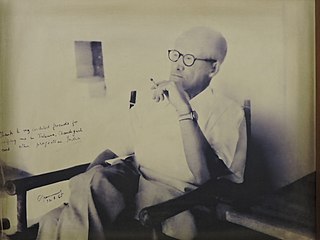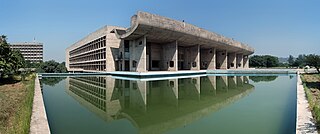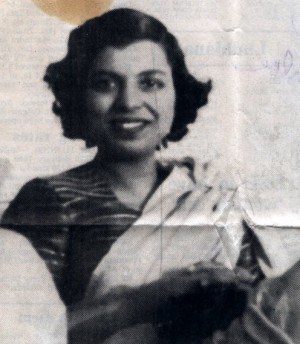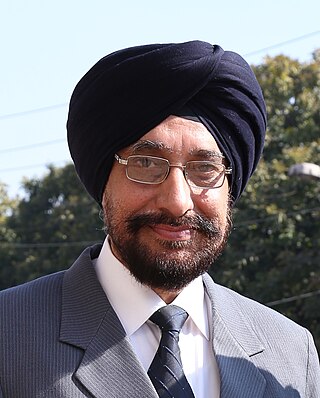
Charles-Édouard Jeanneret, known as Le Corbusier, was a Swiss-French architect, designer, painter, urban planner and writer, who was one of the pioneers of what is now regarded as modern architecture. He was born in Switzerland and acquired French nationality by naturalization on 19 September 1930. His career spanned five decades, in which he designed buildings in Europe, Japan, India, as well as North and South America. He considered that "the roots of modern architecture are to be found in Viollet-le-Duc".

Chandigarh is a union territory and planned city in northern India, serving as the shared capital of the surrounding states, namely Punjab to the north, west and the south, and Haryana to the east. Chandigarh constitutes the bulk of the Chandigarh Capital Region or Greater Chandigarh, which also includes the adjacent satellite cities of Panchkula in Haryana and Mohali in Punjab. It is situated near the foothills of the Himalayas, 260 km north of New Delhi and 229 km southeast of Amritsar.
The year 1953 in architecture involved some significant events.

Panjab University (PU) is an Indian collegiate public state university located in Chandigarh. Funded through both State and Union governments, it is considered a state university. It traces its origins to the University of the Punjab in Lahore, which was founded in 1882. After the partition of India, the university was established on 1 October 1947, and called East Punjab University. Initially housed primarily at a cantonment in Solan, it later relocated to a newly built campus in Chandigarh, and was renamed Panjab University. It is accredited by NAAC at five star level, with the highest NAAC A++ accreditation grade.

Pierre Jeanneret was a Swiss architect who collaborated with his cousin, Charles-Édouard Jeanneret, for about twenty years.

Sukhna Lake in Chandigarh, India, is a reservoir at the foothills of the Himalayas. This 3 km² rain fed lake was created in 1958 by damming the Sukhna Choe, a seasonal stream coming down from the Shivalik Hills. Originally, the seasonal flow entered the lake directly, causing heavy siltation. To check the inflow of silt, 25.42 km² of land was acquired in the catchment area and put under vegetation. In 1974, the Choe was diverted and made to bypass the lake completely, the lake being fed by three siltation pots, minimizing the silt into the lake itself.
Dera Bassi is a satellite city of Chandigarh and a municipal council in Mohali district in the state of Punjab, India. Dera Bassi is located on the Chandigarh – Delhi National Highway, 8 km from Chandigarh. It is located within 20 km from Chandigarh, Mohali and Panchkula. It is strategically located near the boundary of Haryana, Punjab and Union territory of Chandigarh. Derabassi is most famous for its industrial belt, situated for the most part on Ramgarh and Barwala Road. The nearby sub town of Lalru was once a famous market for red chilli powder. The city and the nearby area host eight Engineering, B.Ed., Paramedical and Management institutes.

The Chandigarh College of Architecture (CCA) is a college imparting education and research in the field of architecture. It covers the north-western region of India including the states of Punjab, Haryana, and Himachal Pradesh as well as the Union Territories of Chandigarh and Jammu and Kashmir. The college has an enrolment of 200 undergraduates.

Government Museum and Art Gallery, Chandigarh, is a premier museum of North India having collections of Gandharan sculptures, sculptures from ancient and medieval India, Pahari and Rajasthani miniature paintings. It owes its existence to the partition of India in August, 1947. Prior to the partition, much of the collections of art objects, paintings and sculptures present here were housed in the Central Museum, Lahore, the then capital of Punjab. The museum has one of the largest collection of Gandharan artefacts in the world.

The Pavillon Le Corbusier is a Swiss art museum in Zürich-Seefeld at Zürichhorn dedicated to the work of the Swiss architect Le Corbusier. In 1960, Heidi Weber had the vision to establish a museum designed by Le Corbusier. The building was to exhibit his works of art in an ideal environment created by the architect himself. It was then named the Centre Le Corbusier or Heidi Weber Museum. In April 2014 the building and museum went over to the city of Zürich, and was renamed in May 2016.
Prem Nath Thapar CIE, ICS was a member of the Indian Civil Service in the Punjab region during India's transformation from a British colony to independent nation state.

The Open Hand Monument is a symbolic structure designed by the architect Le Corbusier and located in the Capitol Complex of the Indian city and union territory of Chandigarh. It is the emblem and symbol of the Government of Chandigarh and symbolizes "the hand to give and the hand to take; peace and prosperity, and the unity of mankind". The largest example of Le Corbusier's many Open Hand sculptures, it stands 26 metres (85 ft) high. The metal structure with vanes is 14 metres (46 ft) high, weighs 50 short tons (100,000 lb), and was designed to rotate in the wind.
Governor's Palace is a proposed government building in Chandigarh, India. The building was designed by Le Corbusier, with help from Pierre Jeanneret, a Swiss architect and Corbusier's cousin, but it wasn't built.

The Palace of Assembly is a building in Chandigarh, India which houses the Punjab Legislative Assembly and the Haryana Legislative Assembly. It was designed by modernist architect Le Corbusier. It is part of the Capitol Complex, which includes the Legislative Assembly, Secretariat and High Court. The Palace of Assembly features a circular assembly chamber, a forum for conversation and transactions, and stair-free circulation.

Aditya Prakash, was an architect, painter, academic and published author. He belonged to the first generation of Indian Modernists closely associated with Chandigarh and the developmentalist practices of postcolonial India under Jawaharlal Nehru. He designed over 60 buildings all in north India. His paintings are held in private collections worldwide. His architecture and art adhered strictly to modernist principles. As an academic, he was one of the earliest Indian champions of sustainable urbanism. He published two books and several papers on this topic. His archives are held at the Canadian Centre for Architecture at Montreal, Canada.
Jugal Kishore Choudhury was an Indian architect and urban planner known for his concrete architectural designs.

Urmila Eulie Chowdhury was an Indian architect who worked during the mid-to-late 20th century. She worked in the fields of general architecture, landscape architecture and design, and was also a teacher and writer. She was a pioneer woman architect working in India. Some sources state that she was also the first female architect in Asia. After her education she worked in close collaboration with Le Corbusier in the planning design and construction of the city of Chandigarh.

Diwan Manna is an Indian conceptual artist and photographer. He completed his study in graphic art and printmaking from the Government College of Art, Chandigarh in 1982. He exhibited in India, United Kingdom, Germany, France, Poland, and Italy. From 2014 to 2015 he served as the director of Triennale India, organised by Lalit Kala Akademi, National Academy of Art, Ministry of Culture, Govt of India. He served as the chairman of Chandigarh Lalit Kala Akademi, State Academy of Art, Department of Culture, Chandigarh Administration. Currently, he is serving as the president of Punjab Lalit Kala Akademi, State Academy of Art, Ministry of Culture, Government of Punjab, India.

Sarbjit Singh Bahga is an Indian architect, author and photo-artist. He is known for designing Vidya Sagar Institute of Mental Health, Amritsar, India which was featured in the Guinness World Records for Longest covered concrete corridor.

The Sukhna Interpretation Centre/ Sukhna Gallery is an Indian art museum at Sukhna Lake. It was inaugurated by Manoj Parida who is the Advisor to the Administrator of Chandigarh on 4 December 2019, on the occasion of the 52nd anniversary of the death of Pierre Jeanneret. It was proposed by Deepika Gandhi who is the Director of Le Corbusier Center in May 2019.















